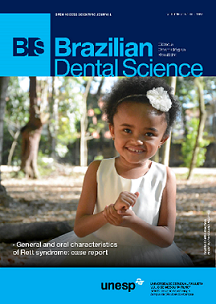Face morphology of brazilian and peruvian populations: analysis of proportion and linear measurement indexes
DOI:
https://doi.org/10.14295/bds.2017.v20i3.1453Abstract
Objective: To compare the proportion and linear measurement indexes between Brazilian and Peruvian population through 3D stereophotogrammetry and to stablish the face profile of these two Latin American populations. Material and Methods: 40 volunteers (Brazilian n=21– 10 males and 11 females; Peruvian n=19 – 8 males and 11 females) aged between 18 and 40 years (mean of 28.7±9.1) had landmarks marked on the face. Then, 3D images were obtained (VECTRA M3) and the indexes of proportion and linear measurement (face, nose, and lips) were calculated. The data were statistically analyzed by One-Way ANOVA (p<0.05). Results: The proportion indexes did not reveal marked differences either between the studied populations or genders (p>0.05). The following linear measurements showed intergroup statistically significant differences: face width and height, nose width and height, upper facial height, mouth width, protrusion of the nose tip (p<0.05). The Brazilian females showed the smallest significant differences. Conclusions: Despite the different ethnic compositions, the Brazilian and Peruvian populations did not differ regarding the proportions of the face, nose, and lips. The differences observed in Brazilian females may be related to gender and/or to the Caucasian heritage of the Brazilian sample.
Keywords
Photogrammetry; Face; Tridimensional Image.
Downloads
Downloads
Published
How to Cite
Issue
Section
License
Brazilian Dental Science uses the Creative Commons (CC-BY 4.0) license, thus preserving the integrity of articles in an open access environment. The journal allows the author to retain publishing rights without restrictions.
=================




























